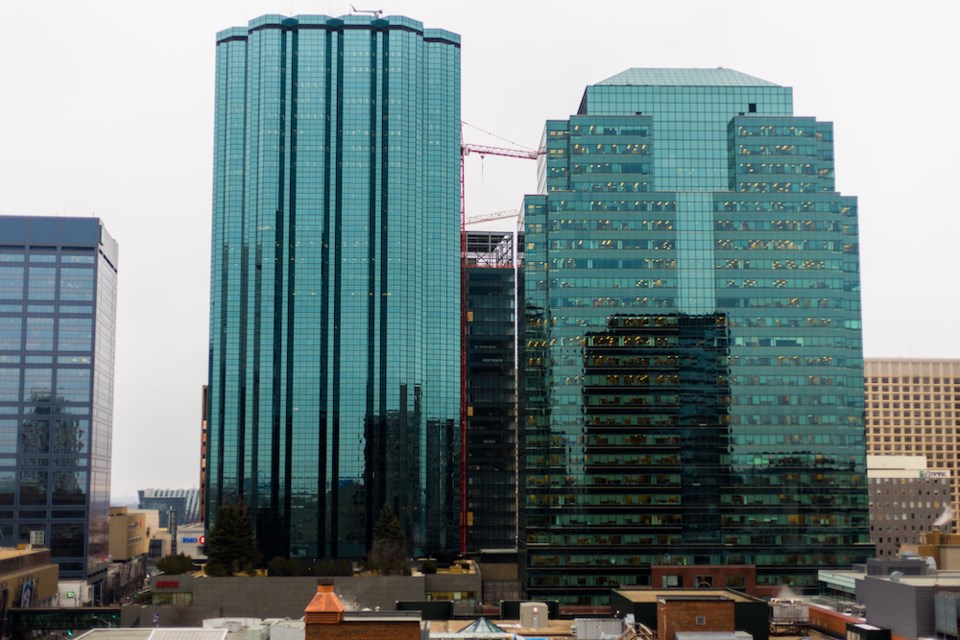Alberta office markets remained resilient in the first quarter, CBRE Ltd. reported Apr. 2, despite softer activity in Calgary.
Vacancies rose 10 basis points in Calgary to 28 per cent overall and 30.3 per cent downtown. Edmonton saw overall vacancies decline to 30 basis points (bps) to 21.1 per cent with downtown falling 60 bps to 22.3 per cent.
The shifts were driven by a flight to quality among tenants, with lower-class options going wanting as tenants shifted into newer, better-class digs.
“We’re starting to see some progress in the office leasing market in both the downtown core and the suburban market,” said Dave Young, executive vice-president and managing director with CBRE in Edmonton. “Clients are starting to make more, longer-term decisions as it relates to office space, and I think those buildings that are highly amenitized will continue to perform, and that’s probably where the absorption will continue.”
Class A vacancies in both Edmonton and Calgary declined, with CBRE reporting a half-percentage point decrease in downtown Calgary to 24.5 per cent. Edmonton held the course at 20.9 per cent, just 10 bps below last quarter.
This reflected national trends.
“Market bifurcation will continue to persist in Canada as lower-quality assets increasingly fall behind,” CBRE reported, noting that Class A vacancies nationally stood at 16.7 per cent in the quarter versus vacancies of 24.4 per cent in Class B/C space.
“Downtown Class B/C vacancy has continued to rise as tenants undergo flight-to-quality moves, leaving increasingly outdated product with little options for backfill,” CBRE reported. “By comparison, Class A product posted a minor improvement in Q1, dropping 20 bps, with seven of 10 markets posting declines.”
“I think it’s a trend we’re going to continue to see,” Young said. “The B and C market is going to be an interesting one to watch. … If you haven’t reinvested in your asset, that’s going to be a problem.”
Owners of older properties in Edmonton have been making investments in order to cater to and keep ahead of tenant demand. A case in point is Manulife Place, where CWB Financial Group announced plans last year to relocate its national headquarters after ICE District Properties shelved plans for a 16-storey office building on 104th Avenue near Rogers Place. CWB was to take 12 floors in the project but will now lease approximately 200,000 square feet at Manulife Place, beginning in January 2026.
Manulife Investment Management announced $30 million worth of renovations to the 745,000-square-foot office tower and associated 103,000-square-foot retail complex, including the addition of a 45,000 square foot rooftop terrace providing an exclusive amenity equivalent to an acre of fully landscaped parkland in the heart of downtown Edmonton.
“Those landlords understand that if they don’t [renovate], they won’t lease any space,” Young said. “Tenant demand is going to be in the better-quality properties.”
Meanwhile, uptake of sublease space has also helped Calgary and Edmonton, which were singled out as the most-improved markets nationally.
“On a year-over-year basis, five markets have seen sublet space decrease, although most notably in Alberta with Calgary and Edmonton,” CBRE said.
Calgary space for sublet now stands at 13.2 per cent of vacancies, down 150 bps versus a year ago, while sublease space in Edmonton is just 7 per cent of total vacancies, down 80 bps versus last year and now the lowest in Western Canada.
The outlook is also positive, with new office construction in Calgary limited to 50,000 square feet in the suburbs, something CBRE considers “in line with demand.” Edmonton has no new space under construction, driving the greater improvement in vacancies.
The average Class A lease rate in Edmonton was $19.53 in the first quarter, below replacement cost, meaning a cap will remain on new construction for the foreseeable future.
However, with the strongest population growth in the country last year and robust growth prospects, Alberta office markets look set for continued improvement in 2024.
“We’ve seen strong in-migration in Alberta – Edmonton and Calgary – GDP growth has been strong,” Young said. “We’re excited what the future holds for both the major cities and the general regions around them.”



